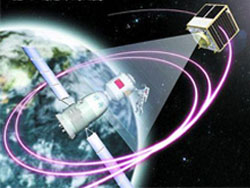
The spacecraft Shenzhou-7 blasted off on 25 September, carrying three astronauts to attempt the China's first-ever space walk. It is the seventh space mission successfully launched by this country. As usual, its space application system, one of the seven major systems of space engineering, is developed under the leadership of CAS.
The system will perform three main tasks during the mission, according to Prof. GU Yidong, chief engineer of the space application system of the Shenzhou-7 and a researcher from the Academy of Opto-electronics under CAS.
First, in cooperation with local partners in Shanghai, CAS has built a small monitoring satellite for the mission. It will be released after a taikonaut make the nation's first step in outer space. It is China's first attempt to launch a tributary satellite using a spacecraft.
Second, an experiment will be conducted on the outer-space-exposure of solid lubricants. The test is designed to understand the performance decay and failure mechanism of materials in outer space, so as to improve properties of solid lubricants for mechanical parts of a spaceship.
Third, long and mid- and short-term forecasts on space environment are made in various stages of the mission. Abnormal events in this regard will be alerted. In addition, the operation of the effective payloads onboard the spaceship will be monitored and controlled by CAS researchers.
Over the past six space missions, nearly 30 tasks were undertaken by CAS researchers and their co-workers for the application system in such fields as spaceborne remote sensing, space astronomical observation, Earth environment observation, space life sciences, space materials sciences, space environment monitoring and forecasts. Over 200 payloads for spacecrafts were developed.







